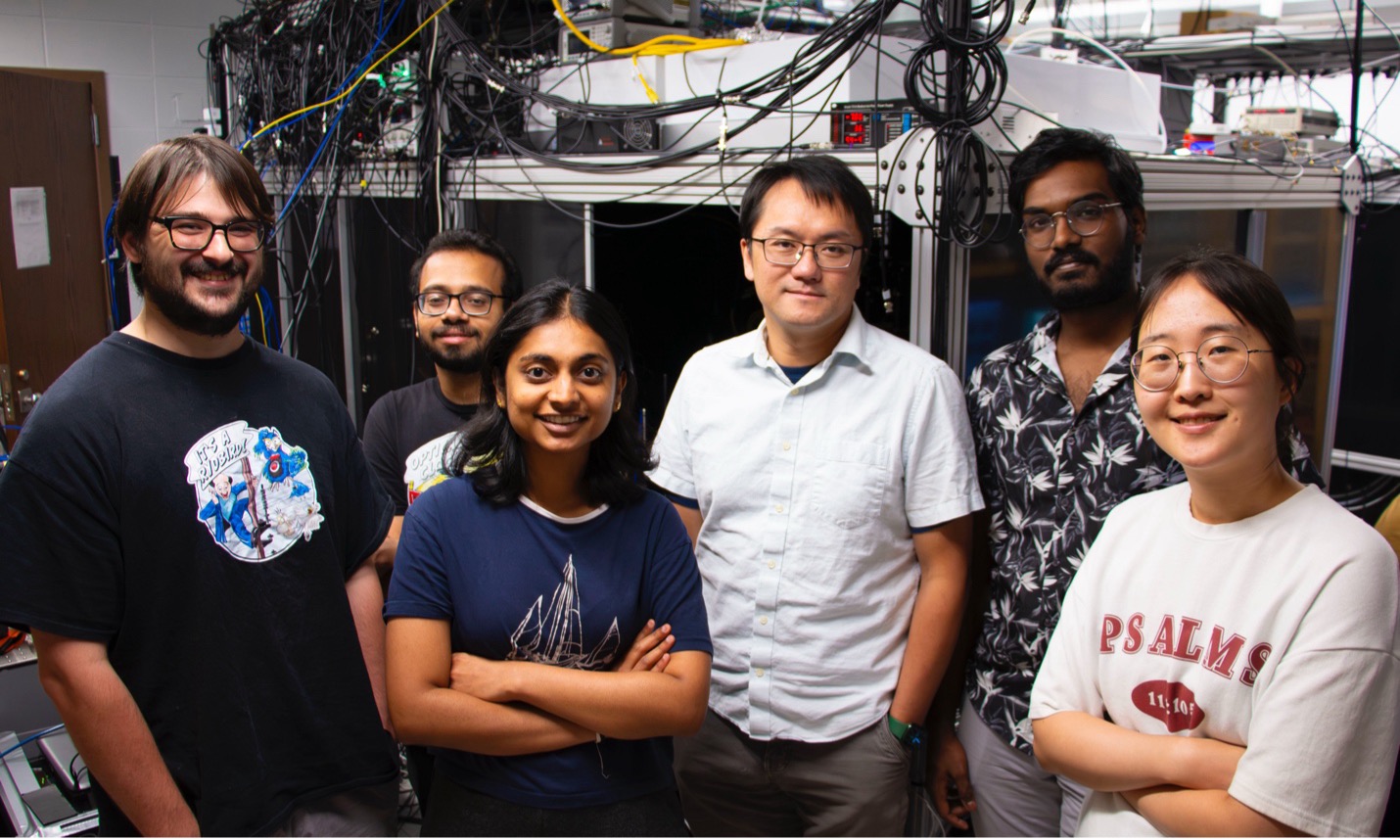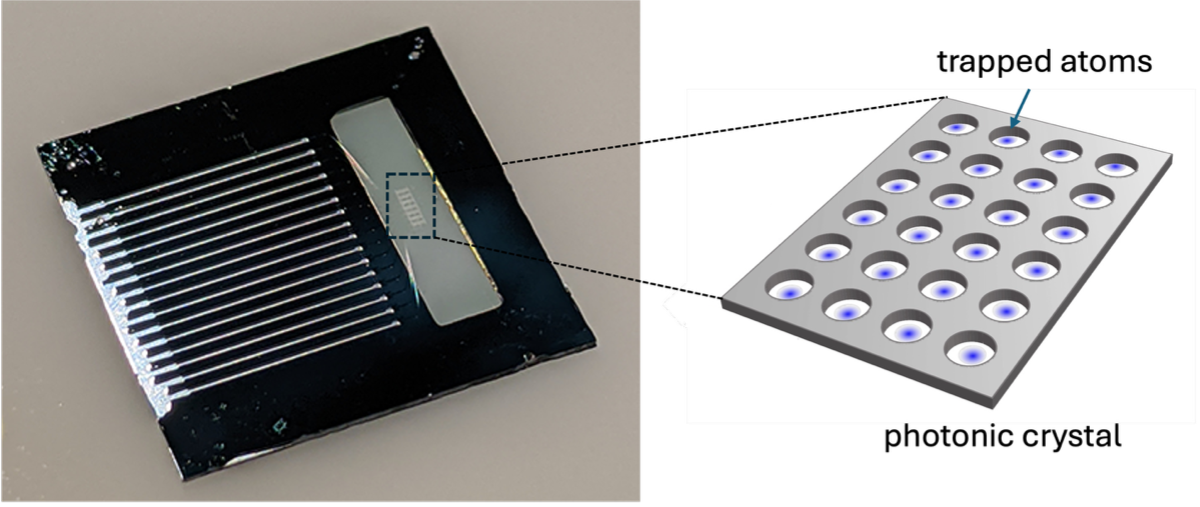Purdue Physicist named Moore Foundation Experimental Physics Investigator
2025-10-08

Left to right: Kenneth Scalzi, Dipanjan Das, Shreya Jeedigunta, Chen-Lung Hung, Saivirinchi Prabandhakavi, Ahreum Lee (Photo by/David Siple)
A Purdue University physicist has been named a Gordon and Betty Moore Foundation Experimental Physics Investigator, joining a select group of grantees pushing the frontiers of experimental physics. The program provides $1.3 million over five years and will enable the Purdue team to design new types of quantum materials, built from the ground up using atoms and light.
This recognition was awarded to Chen-Lung Hung, professor of physics and astronomy at Purdue University, whose research focuses on engineering ultracold quantum matter made with atoms and photons. The 2025 cohort of Experimental Physics Investigators consists of a distinguished group of 22 mid-career researchers pushing the boundaries of experimental physics.
Hung's team includes postdoctoral researcher Ahreum Lee (joining from the University of Maryland), and Purdue physics PhD students Saivirinchi Prabandhakavi, Dipanjan Das, Shreya Jeedigunta and Kenneth Scalzi. Their work takes place in Hung's Ultracold Atoms and Nanophotonics Laboratory, which specializes in trapping and manipulating atoms at temperatures a fraction above absolute zero. Hung’s work with recent group alumni, Xinchao Zhou, Tzu-Han Chang and Hikaru Tamura, laid the foundation for the research project; see how atoms are trapped on a circuit to serve as photonic transistors.
"Our program will advance atomic physics, optical physics, quantum science and technology," Hung said. "We will introduce new methods to create complex quantum matter on a photonic circuit, offering significant opportunities to develop chip-based atom-array quantum systems that are useful for future quantum technologies such as quantum sensing using portable optical circuits integrated with cold atoms, quantum computing using atom-photon hybrids and enhanced quantum information storage and distribution in photonic circuits."
The project merges two groundbreaking technologies: atom arrays and photonic crystals. Scientists first learned to laser-cool atoms in the late 20th century, slowing them to near stillness and capturing them with "optical tweezers." This enabled precise control over individual atoms and eventually their arrangement into ordered arrays for quantum computing.
In parallel, photonic crystals, which are materials with periodic structures that control how light moves, emerged in the 1980s and revolutionized optics. Hung's group will bring these two worlds together by coupling arrays of cold atoms with nanofabricated photonic circuits to create new kinds of engineered matter.

Photo of a nanophotonic chip and schematic of atom array integration in a photonic crystal. (Figure credit/Hung lab)
"The program offers significant resources over five years, allowing me to pursue the cutting-edge research that I have been dreaming about," Hung said. "It also connects us with other Moore Investigators, opening collaboration opportunities to advance science that may not be possible without the Moore Foundation's support."
The project will be carried out in Purdue's recently renovated physics labs, designed to better meet the stringent requirements of modern quantum experiments. Collaborations with the Birck Nanotechnology Center, which provides state-of-the-art nanofabrication facilities, make it possible to create the photonic circuits used in the experiments. Hung is also affiliated with the Purdue Quantum Science and Engineering Institute, which brings together researchers across disciplines to advance quantum technologies.
Over the next five years, Hung and his team plan to integrate cold atoms with lithographically patterned photonic crystals, creating materials with entirely new properties. These hybrid systems could store and redistribute quantum light, act as new platforms for quantum communication and provide new schemes for quantum computing.
"This program will advance the frontiers of quantum science by creating a quantum material whose constituent particles are fully controlled and engineered," Hung said. "We are at a moment where the tools exist to design materials atom by atom and photon by photon. That's an exciting step forward for both fundamental science and real-world applications."
The Gordon and Betty Moore Foundation, established by Intel co-founder Gordon Moore and his wife Betty, advances scientific discovery, environmental conservation, and the special character of the San Francisco Bay Area. More information about the Experimental Physics Investigator Initiative is available on the foundation's website.
According to the Moore Foundation, Experimental Physics Investigators awards are intended to select and support outstanding individual investigators who are advancing cutting-edge research in experimental physics that improves scientific understanding of the natural world. The initiative also hosts convocations and fosters collaboration that will lead to new discoveries.
About the Department of Physics and Astronomy at Purdue University
Purdue’s Department of Physics and Astronomy has a rich and long history dating back to 1904. Our faculty and students are exploring nature at all length scales, from the subatomic to the macroscopic and everything in between. With an excellent and diverse community of faculty, postdocs and students who are pushing new scientific frontiers, we offer a dynamic learning environment, an inclusive research community and an engaging network of scholars.
Physics and Astronomy is one of the seven departments within the Purdue University College of Science. World-class research is performed in astrophysics, atomic and molecular optics, accelerator mass spectrometry, biophysics, condensed matter physics, quantum information science, and particle and nuclear physics. Our state-of-the-art facilities are in the Physics Building, but our researchers also engage in interdisciplinary work at Discovery Park District at Purdue, particularly the Birck Nanotechnology Center and the Bindley Bioscience Center. We also participate in global research including at the Large Hadron Collider at CERN, many national laboratories (such as Argonne National Laboratory, Brookhaven National Laboratory, Fermilab, Oak Ridge National Laboratory, the Stanford Linear Accelerator, etc.), the James Webb Space Telescope, and several observatories around the world.
The Gordon and Betty Moore Foundation advances scientific discovery, environmental conservation, and the special character of the San Francisco Bay Area. Visit moore.org and follow @MooreFound.
Written by: David Siple, communications specialist, Purdue University Department of Physics and Astronomy